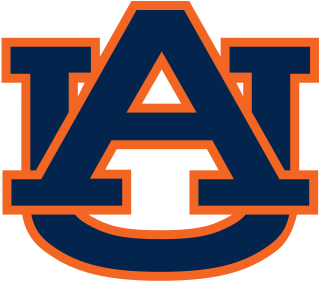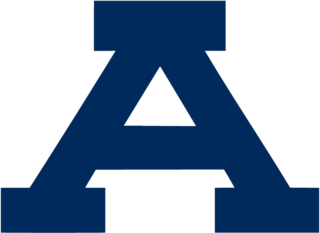
The 1950 Florida Gators football team represented the University of Florida during the 1950 college football season. The season was Bob Woodruff's first of ten as the new head coach of the Florida Gators football team. Woodruff was a former college football player and assistant for coach Robert Neyland's Tennessee Volunteers, who made his name as an up-and-coming young head coach leading the Baylor Bears for three seasons in the late 1940s. Like Neyland, Woodruff emphasized stout defense, the kicking game and a ball control offense. In Woodruff's first season of 1950, the Gators offense, led by quarterback Haywood Sullivan and offensive coordinator Frank Broyles, posted record numbers. Sullivan was the first sophomore in SEC history to throw for more than 1,000 yards in a season. He set nine school records. The highlights of the season included two Southeastern Conference (SEC) victories over the Auburn Tigers (27–7) and the No. 13-ranked Vanderbilt Commodores (31–27)—the first season since 1940 in which the Gators won two or more SEC games. The Gators' No. 20 ranking after the Vanderbilt game marked their first-ever appearance in the top twenty of the weekly Associated Press Poll. Woodruff's 1950 Florida Gators finished 5–5 overall and 2–4 in the SEC, placing tenth among twelve conference teams.
The 1952 Florida Gators football team represented the University of Florida during the 1952 college football season. The season was Bob Woodruff's third and most successful as the head coach of the Florida Gators football team. Woodruff's 1952 Florida Gators finished with an overall record of 8–3 and a Southeastern Conference (SEC) record of 3–3, placing sixth among twelve SEC teams.
The 1953 Florida Gators football team represented the University of Florida during the 1953 college football season. The season was the fourth for Bob Woodruff as the head coach of the Florida Gators football team. The 1953 season was a year of rebuilding and backsliding after the graduation of All-American Charlie LaPradd and the loss of fullback Rick Casares to the U.S. Army. The highlight of the season was the Gators' second consecutive victory over the Georgia Bulldogs, but the Gators began a pattern of agonizingly close losses to the Rice Owls (16–20), Auburn Tigers (7–16), Tennessee Volunteers (7–9) and Miami Hurricanes (10–14), as well as two ties with the Georgia Tech Yellow Jackets (0–0) and LSU Tigers (21–21). Woodruff's 1953 Florida Gators finished with a 3–5–2 overall record and a 1–3–2 record in the Southeastern Conference (SEC), placing ninth of twelve SEC teams.
The 1954 Florida Gators football team represented the University of Florida during the 1954 college football season. The season was the fifth for Bob Woodruff as the Florida Gators football team's head coach. The Gators' standout players included running back Mal Hammack. The season was one of mixed results for the Gators: their best-ever Southeastern Conference (SEC) win–loss record, balanced by five overall losses. The highlights of the season were five SEC wins over the fifth-ranked Georgia Tech Yellow Jackets (13–12), Auburn Tigers (19–13), Kentucky Wildcats (21–7), Mississippi State Maroons (7–0) and Tennessee Volunteers (14–0). Woodruff's 1954 Florida Gators finished 5–5 overall and 5–2 in the SEC, placing third in the twelve-team conference—their best SEC showing to date.
The 1955 Florida Gators football team represented the University of Florida during the 1955 college football season. The season was Bob Woodruff's sixth as the head coach of the Florida Gators football team. The Gators played their only eight-game Southeastern Conference schedule before the 1990s, and probably the most difficult of the 1950s. The standout Gator players included offensive and defensive tackle John Barrow, halfback and punter Don Chandler, two-way halfback Jackie Simpson and defensive back John Symank. The highlights of the 1955 season included three conference victories over the Mississippi State Maroons (20–14), LSU Tigers (18–14), and Georgia Bulldogs (19–13). The Gators closed out the season with a knife's edge 7–6 road loss to the Miami Hurricanes in their home stadium in Miami, Florida. Woodruff's 1955 Florida Gators finished 4–6 overall and 3–5 in the SEC, placing tenth of twelve teams in the conference.
The 1956 Florida Gators football team represented the University of Florida during the 1956 NCAA University Division football season. The season was the seventh for Bob Woodruff as the head coach of the Florida Gators football team. The Gators were led by All-American tackle John Barrow, quarterback Jimmy Dunn, two-way halfbacks Joe Brodsky, Bernie Parrish, Jim Rountree and Jackie Simpson, and defensive back John Symank. The highlights of the season included conference road wins over the Mississippi State Maroons (26–0) in Starkville, Mississippi, the Vanderbilt Commodores 21–7 in Nashville, Tennessee, and the LSU Tigers 21–6 in Baton Rouge, Louisiana, a shutout homecoming victory over the Auburn Tigers (20–0), and a second consecutive win over the Georgia Bulldogs (28–0). Woodruff's 1956 Florida Gators started a promising 6–1–1, but lost their final two games to finish 6–3–1 overall and 5–2 in the Southeastern Conference, placing third in the SEC among twelve teams.
The 1958 Florida Gators football team represented the University of Florida during the 1958 NCAA University Division football season. The season was the ninth of ten for Bob Woodruff as the head coach of the Florida Gators football team. Woodruff's 1958 Florida Gators finished with an overall record of 6–4–1 and a Southeastern Conference (SEC) record of 2–3–1, placing eighth in the twelve-member SEC.
The 1959 Florida Gators football team represented the University of Florida during the 1959 NCAA University Division football season. The season was Bob Woodruff's tenth and last year as the head coach of the Florida Gators football team. The Gators celebrated a close conference win over the Mississippi State Maroons (14–13), and suffered close conference defeats to the Vanderbilt Commodores (6–13), the top-ranked LSU Tigers (0–9) and the eighth-ranked Auburn Tigers (0–6). Woodruff finished his tenure on a high note, with the Gators' victories over the Florida State Seminoles (18–8) and the twelfth-ranked Miami Hurricanes (23–14), their primary in-state rivals. Woodruff's 1959 Florida Gators finished with an overall record of 5–4–1 and a Southeastern Conference (SEC) record of 2–4, placing ninth among twelve SEC teams.
The 1960 Florida Gators football team represented the University of Florida during the 1960 NCAA University Division football season. The season was Ray Graves' first of ten and one of his three most successful as the head coach of the Florida Gators football team. Graves' 1960 Florida Gators finished with a 9–2 overall record a 5–1 record in the Southeastern Conference (SEC), placing second among the twelve SEC teams—their best-ever SEC finish to date.
The 1964 Florida Gators football team represented the University of Florida during the 1964 NCAA University Division football season. The season was the fifth for Ray Graves as the head coach of the Florida Gators football team. Graves' 1964 Florida Gators posted an overall record of 7–3 and a 4–2 Southeastern Conference (SEC) record, tying for second among the eleven SEC teams.

The 1966 Florida Gators football team represented the University of Florida in the sport of American football during the 1966 NCAA University Division football season. The Gators competed in the University Division of the National Collegiate Athletic Association (NCAA) and the Southeastern Conference (SEC). In their seventh season under head coach Ray Graves, the Gators compiled a 9–2 overall win–loss record, finished 5–1 and placed third among the SEC's ten teams. Led by quarterback Steve Spurrier, the Gators outscored their opponents by a combined total of 265 to 147 and concluded their 1966 season with a 27–12 victory over the Georgia Tech Yellow Jackets in the 1967 Orange Bowl. The Gators were not ranked in the final AP Poll, but finished No. 11 in the final UPI Coaches Poll.
The 1973 Florida Gators football team represented the University of Florida during the 1973 NCAA Division I football season. The season was Doug Dickey's fourth as the Florida Gators football team's head coach. Dickey's 1973 Florida Gators finished with a 7–5 overall record and a 3–4 Southeastern Conference (SEC) record, tying for fifth among ten SEC teams.
The 1975 Florida Gators football team represented the University of Florida during the 1975 NCAA Division I football season. The season was Doug Dickey's sixth and most successful season as the head coach of the Florida Gators football team. Dickey's 1975 Florida Gators finished with a 9–3 overall record and a 5–1 Southeastern Conference (SEC) record, tying for second among ten SEC teams. The team featured consensus All-American linebacker Sammy Green.
The 1990 Florida Gators football team represented the University of Florida during the 1990 NCAA Division I-A football season. The season marked the return of the Gators' Heisman Trophy-winning quarterback Steve Spurrier to his alma mater as the new head coach of the Florida Gators football team.
The 1992 Florida Gators football team represented the University of Florida during the 1992 NCAA Division I-A football season. The season was Steve Spurrier's third as the Florida Gators football team's head coach, and the wins were harder to come by as the star-studded senior classes from 1990 and 1991 had graduated. The Gators racked up six tough Southeastern Conference (SEC) wins over the Kentucky Wildcats (35–19), LSU Tigers (28–21), Auburn Tigers (24–9), seventh-ranked Georgia Bulldogs (26–24), South Carolina Gamecocks (14–9), and Vanderbilt Commodores (41–21). They also suffered two crushing SEC losses to the fourteenth-ranked Tennessee Volunteers (14–31) in Knoxville, Tennessee, and the twenty-fourth-ranked Mississippi State Bulldogs (6–30) on a Thursday night in Starkville, Mississippi.
The 1993 Florida Gators football team represented the University of Florida during the 1993 NCAA Division I-A football season. The season was the fourth for Steve Spurrier as the head coach of the Florida Gators football team. The Gators compiled a 10–2 overall record.
The 1965 Kentucky Wildcats football team represented the University of Kentucky in the Southeastern Conference during the 1965 NCAA University Division football season. The Wildcats scored 202 points while allowing 160 points, finishing 6-4 overall, 3-3 in the SEC.

The Auburn–Florida football rivalry is an American college football rivalry between the Auburn Tigers football team of Auburn University and Florida Gators football team of the University of Florida which was first played in 1912. The schools have been members of the same athletic conference for over a century and were founding members of the Southeastern Conference (SEC) when it was established in 1933. The contest was an annual tradition from 1945 until 2002, when the SEC expanded and the rivalry became part of a rotation of other conference games. Since then, the teams have met only four times.

The 1970 Auburn Tigers football team represented Auburn University in the 1970 NCAA University Division football season. Under the leadership of head coach Ralph Jordan, Tigers completed the regular season with a record of 8–2. Auburn won the Gator Bowl against Ole Miss by a score of 35–28. They completed the season with a record of 9–2 and were ranked No. 10 in the AP poll and No. 9 in the Coaches Poll.
The 1972 Auburn Tigers football team under the leadership of coach Ralph "Shug" Jordan completed the regular season with a record of 9–1, earning them an invitation to the Gator Bowl against Colorado, which they won by a score of 24–3. They completed the season with a record of 10–1 and ranked #5 in the AP poll and #7 in the UPI.



